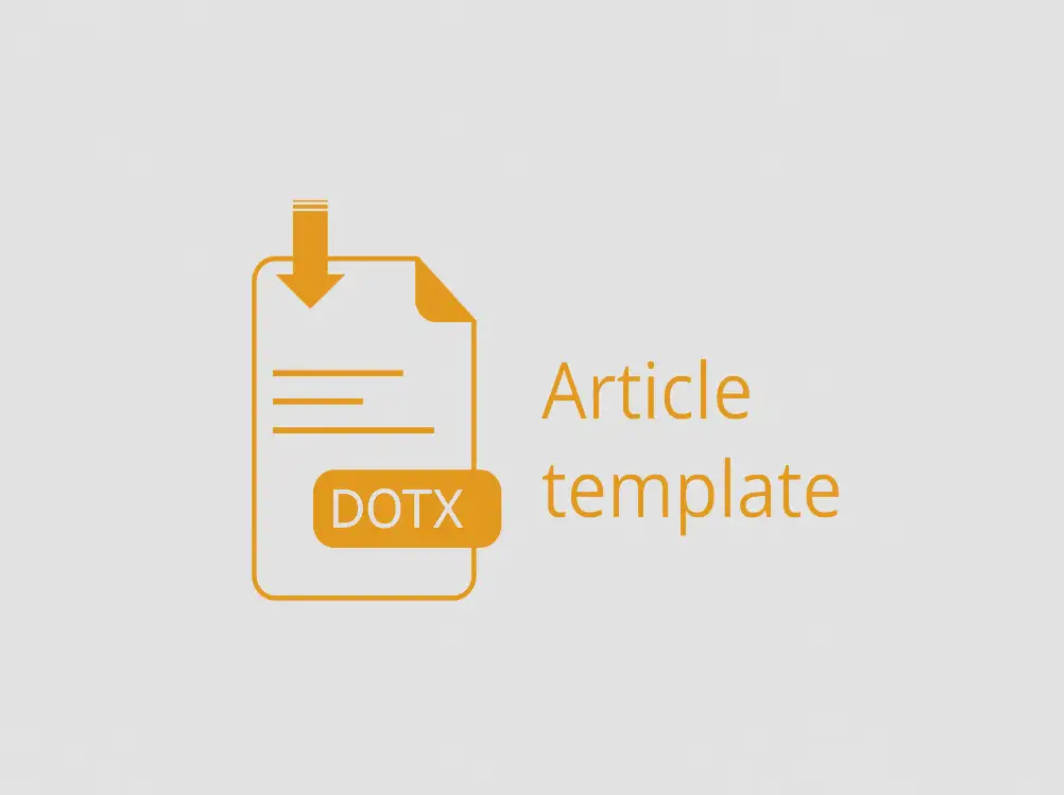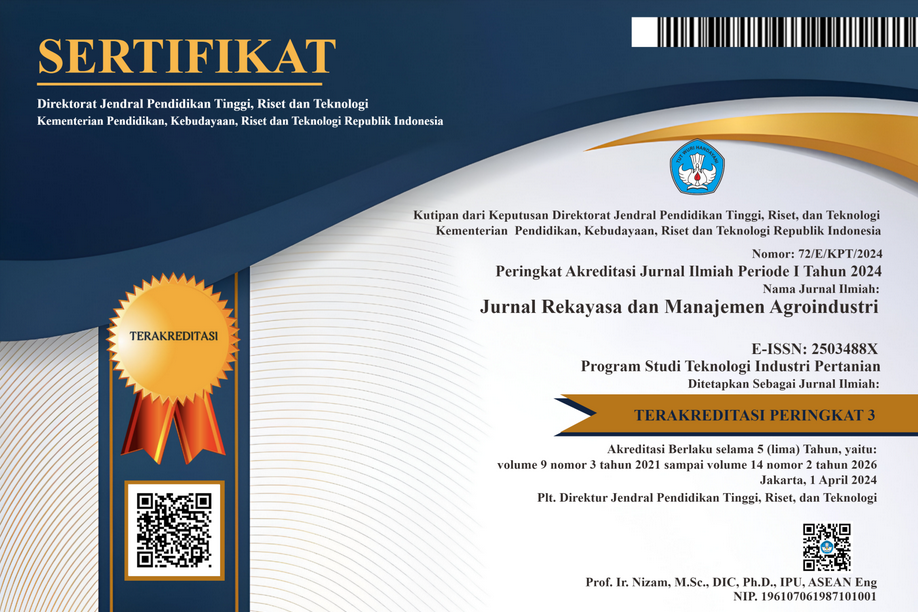Kajian Pengembangan Metode Ekstraksi Soxhletasi Terhadap Kadar Antioksidan Ekstrak Daun Matoa (Pomitea pinnata) Menggunakan Spektrofotometer UV VIS
Abstract
This study aims to examine the development of extraction methods for antioxidant capacity testing using a spectrophotometer on matoa leaf extract. The extraction method used is the soxhletation method. Factors that affect the extraction process with Soxhlet tools include extraction time and solvent concentration. The treatments used in this study were ethanol concentration (60%, 70%, 80% and 90%) and extraction time (3, 4, 5, and 6 hours), Determination of the best solvent concentration and extraction time was carried out by calculating the antioxidant content of the DPPHspectrophotometer method. The results showed that 70% ethanol concentration with extraction time for 4 hours was the best treatment that obtained antioxidant capacity of 5.54% with extract yield of 35.00%. The antioxidant capacity of matoa leaf extract obtained ranged from 3.15-5.54% with the yield value of matoa leaf extract obtained ranged from 19.36 - 35.00% which has color characteristics, namely the range of L* values of 13.39 to 20.44, the range of a* values ranging from - 3.62 to 0.43 and the range of b* values ranging from -7.50 to -3.31. The soxhletation method can be used as one of the extraction methods to obtain matoa leaf extract and the use of UV-VIS spectrophotometric method can also be used as one of the methods for testing the antioxidant capacity of matoa leaf extract.
Keywords : matoa leaf, extraction, soxhletation device, solvent concentration, extraction time.
Penelitian ini bertujuan untuk mengkaji pengembangan metode ekstraksi terhadap pengujian kapasitas antioksidan menggunakan alat spektrofotometer pada ekstrak daun matoa. Metode ekstraksi yang digunakan adalah metode soxhletasi. Faktor yang mempengaruhi proses ekstraksi dengan alat Soxhlet diantaranya waktu ekstraksi dan konsentrasi pelarut. Perlakuan yang digunakan dalam penelitian ini adalah konsentrasi etanol (60%,70%,80% dan 90%) dan waktu ekstraksi (3,4,5, dan 6 jam), Penentuan konsentrasi pelarut dan waktu ekstraksi terbaik dilakukan dengan perhitungan kadar antioksidan metode DPPH-spektrofotometer. Hasil penelitian menunjukkan bahwa konsentrasi etanol 70% dengan waktu ekstraksi selama 4 jam merupakan perlakuan terbaik yang memperoleh kapasitas antioksidan sebesar 5,54% dengan rendemen ekstrak sebesar 35,00%. Kapasitas antioksidan ekstrak daun matoa yang diperoleh berkisar antara 3,15-5,54% dengan nilai rendemen ekstrak daun matoa yang didapatkan berkisar antara 19,36 – 35,00% yang memiliki karakteristik warna yaitu kisaran nilai L* yaitu sebesar 13,39 hingga 20,44, Kisaran nilai a* berkisar antara -3,62 hingga 0,43 dan kisaran nilai b* berkisar antara-7,50 hingga -3,31. Metode soxhletasi dapat digunakan sebagai salah satu metode ekstraksi untuk mendapatkan ekstrak daun matoa dan penggunaan metode spektrofotometri UV-VIS juga dapat digunakan sebagai salah satu metode untuk pengujian kapasitas antioksidan ekstrak daun matoa.
Kata kunci : alat soxhletasi, daun matoa, ekstraksi, konsentrasi pelarut, waktu ekstraksi.
Downloads
References
Anonim. 2000. Parameter Standar Umum Ekstrak Tanaman Obat. Cetakan Pertama. 10-11. 16
Departemen Kesehatan Republik Indonesia. Jakarta.
AOAC. 1990. Official Method of Analysis of Association Official Agriculture Chemist. Association
of Official Analytical Chemists, Inc, Washington D.C.
Dalimartha, S. 2005. Atlas Tumbuhan Obat Indonesia, Jilid I. Jakarta: Trubus Agriwijaya. Hal 120-
125.
Departemen Kesehatan RI. 1985. Cara Pembuatan Simplisia. Jakarta : Direktorat Jendral POM-
Depkes RI
Kemit, N., I. W. R. Widarta dan K.A. Nocianitri. 2015. Pengaruh jenis pelarut dan waktu maserasi
terhadap kandungan senyawa flavonoid dan aktivitas antioksidan ekstrak daun alpukat (Persea
Americana Mill). E Jurnal Itepa Universitas Udayana. 1: 130-141.
Lestari, P., S. Wijana, dan W.I. Putri. 2014. Ekstraksi Tanin dari Daun Alpukat (Persea americana
Mill.) sebagai Pewarna Alami (Kajian Proporsi Pelarut dan Waktu Ekstraksi). Tesis S2. Tidak dipublikasikan. Program Pascasarjana Universitas Brawijaya, Malang.
Shadmani A., Azhar I., Mazhar F., Hassan M.M., Ahmed SW., Ahmad I., Usmanghani K., &
Shamim, S. 2004. Kinetic studies on Zingiber Officinale. Pakistan Journal of Pharmaceutical Sciences, 17(1): 47-54.
Sompong R, Siebenhandl-Ehn S, Linsberger-Martin G, Berghofer E. 2011. Physicochemical and
antioxidative properties of red and black rice varieties from Thailand, China and Sri Lanka. Food Chem 124: 132-140. DOI: 10.1016/j.food chem.2010.05.115.
Suryani, N.C., D.G.M. Permana, dan A.A.G.N.A. Jambe. 2016. Pengaruh jenis pelarut terhadap
kandungan total flavonoid dan aktivitas antioksidan ekstrak daun matoa (Pometia pinnata). Jurnal Ilmu dan Teknologi Pangan. 5(1):1-10.
Tiwari, P., Kumar, B., Kaur, M., Kaur, G. & Kaur, H. (2011) Phytochemical Screening and
Extraction: A Review. Internationale Pharmaceutica Sciencia, 1, 98- 106.
Turkmen, N., F. Sari dan Y.S. Velioglu. 2006. Effect of extraction solvents on concentration and
antioxidant activity of black and black mate polyphenols determined by ferrous tartrate and Folin- Ciocalteu methods. Food Chemistry. 99(4): 838-841. doi.org/10.1016/j.foodchem.2005.08.034.
Utami. 2009. Potensi daun alpukat (Persea americana Mill) sebagai sumber antioksidan alami. Jurnal
Teknik Kimia UPN. Jawa Timur. Vol 2 (1) : 58-64.

Ciptaan disebarluaskan di bawah Lisensi Creative Commons Atribusi-BerbagiSerupa 4.0 Internasional.
Seluruh artikel di Jurnal ini dapat disebarluaskan atas tetap mencantumkan sumber yang syah. Identitas judul artikel tidak boleh dihilangkan. Penerbit tidak bertangggung jawab terhadap naskah yang dipublikasikan. Isi artikel menjadi tanggung jawab Penulis.














